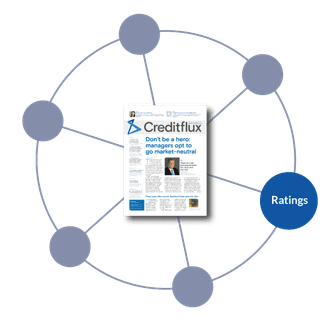

June 2021 | Issue 235
Analysis
CLOs
Lighten up, these are due an upgrade

Charlie Dinning
Data journalist

Tanvi Gupta
Head of data journalism
CLO triple C buckets were overflowing last year, but the average exposure is now 7.3%. That is still close to trigger levels, but CLO managers are relaxed, as further loan upgrades are on the horizon
A year on from the coronavirus-induced volatility and subsequent rating agency downgrade frenzy, and triple C buckets in reinvesting US CLOs are right up against the standard 7.5% threshold. CLOs run two triple C tests across rating agencies and the average triple C exposure on the higher of those is 7.3%, according to our dataset of pre-2020 CLOs. On average, 31 CLO managers are above the 7.5% limit across their portfolios.
S&P triple C buckets are higher than their Moody’s counterpart. Across our data, the average S&P triple C bucket was 7.3% compared to 6% for Moody’s. Sources say the difference is down to methodology: Moody’s rates at the facility level, while S&P assigns an issuer rating, which tends to give a lower figure.
US CLOs: triple C (%) vs junior OC cushion (%)
Highest average triple C exposure
Credit Suisse Asset Management has the highest average triple C exposure in its reinvesting US CLOs, with 12.2% across 28 deals. This is the highest for a CLO manager without a triple C-flex CLO under management. KKR has the second highest average triple C bucket at 11.8% across 18 CLOs.
Of the top 50 US CLOs with the highest triple C buckets as of 15 March to 15 April trustee reports, 24 are managed by CSAM and 15 by KKR. Assured Investment Management (Fuji) and Wellfleet Credit Partners contribute four CLOs each to the top 50.
To manage triple C buckets and over-collateralisation (OC) tests at the height of the coronavirus crisis, US CLO managers either traded out of triple C credits (and risked burning par), or kept the credits they believed would recover post-covid. Those managers that took the long-term view and held on to their triple C credits are now starting to reap the rewards, with triple C credits the highest returning loan rating since the beginning of the covid-induced volatility. Many of these loans are now
trading in the high 90s.
$1.4bn
Total IMG loans in CLOs in our data upgraded from triple C
12.2%
CSAM CLOs have highest average triple C exposure
This has meant that CLO managers which opted to hold triple C credits in their portfolios can now reposition and reduce their triple C buckets and warf without excessive par loss.
But it took a strong nerve to hold on to assets amid the deluge of downgrades last year. In April and May 2020, Moody’s and S&P downgraded 145 CLO loans, which hurt $49.4 billion of US portfolios and €6.8 billion of European CLOs. A slow recovery has begun, with 33 CLO loans upgraded out of triple C levels by Moody’s or S&P between 1 March and 15 May. That has boosted $8.8 billion of CLO portfolios in the dataset (see methodology).
Of the 33 corporate debt issuers to be upgraded out of triple C, IMG (William Morris Endeavor) had the largest impact on CLO portfolios. The firm’s loans occupy $1.4 billion of CLO pools across 480 deals. IMG, a sports, events and talent management company, was upgraded from CCC+ to B on 29 April. CSAM has the largest exposure to the debt issuer, with $182.8 million across 28 CLOs.
* Taken from 03-July trustee report ** Deal has optional redemption notice out for April
Golub benefits from triple C bounce
Every CLO manager benefited from upgrades to some degree, but Golub Capital benefited the most. The manager had a 5.5% portfolio exposure to triple C-rated corporate debt issuers across nine CLOs. CSAM had the largest notional exposure to upgraded issuers, $681.2 million, equating to 2.9% of its portfolio across the 28 CLOs in the dataset.
The pace of upgrades is noticeably slower than the rate of downgrades last year, but market participants say this is because there is still uncertainty in the corporate credit market. “Yes the economy is on fire, but you’re still not sure of the leverage levels in some of the companies that were hit,” says a New York-based CLO manager.
8.1%
Junior OC cushion on low levered CLO AGL Core 2
Nevertheless, CLOs are in rude health. The average junior OC cushion across CLOs with a standard 7.5% triple C bucket in our dataset was 2.9%. Only six reinvesting US CLOs were failing their junior OC test between March and April trustee reports: two triple C-flex CLOs managed by Ellington Management Group and four US CLOs with 7.5% triple C limits.
AGL Credit Management has the highest average junior OC cushion among US CLO managers. The manager has two CLOs in our dataset, with its debut CLO, AGL I, registering a junior OC cushion of 5.19% and 8.12% on AGL Core 2.
AGL Core 2 is part of the manager’s low-levered series of CLOs. It has three debt tranches (two triple A-rated, one double A-rated) and two turns of leverage.
2.9%
Average junior OC cushion in CLOs with 7.5% triple C bucket
CLO investors split over high triple Cs
Investor attitude towards triple C exposure differs depending on where they are in the capital stack, sources say. Equity and junior debt investors are generally comfortable with high triple C buckets as they are seen as preferable to burning par in the CLO, according to one equity investor. But triple A investors may have a different stance, especially if the CLO is being reset.
One investor says: “When you’re resetting a deal, triple A investors tend to say triple C exposure needs to be a certain percentage, which can lead to a lot of back and forth as equity investors do not want to force managers to sell.”
One CLO manager also points to the rating agency methodology on a reset, which tends to require managers clean up a portfolio and reduce triple C exposure.
* Upgraded from triple C between 1 March — 15 May ** As of 28 February Shading denotes total exposure to top 10 upgraded credits
Methodology
- Triple C buckets figure is the larger of the percentage exposure recorded by Moody’s and S&P.
- Junior OC cushion indicates the difference between the result and the trigger value of the overcollateralisation test for the most junior debt class.
Data
- Data is as of 15-Mar to 15-Apr trustee reports, or closest available, and includes all reinvesting US CLOs at time of calculation.
- Triple C flex deals. bond flex CLOs and 2020/2021 vintage CLOs are excluded.
- Data is sourced from CLO-i and Moody’s Analytics.
Share this article:

Global credit funds & CLO's
June 2021 | Issue 235
Published in London & New York.
Copyright Creditflux. All rights reserved. Check our Privacy Policy and our Terms of Use.
























